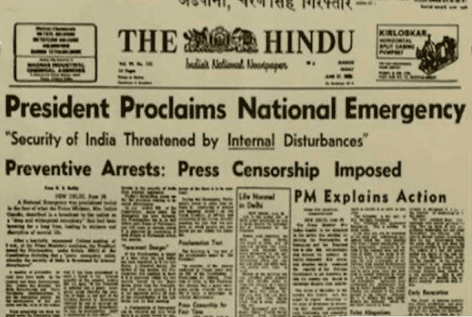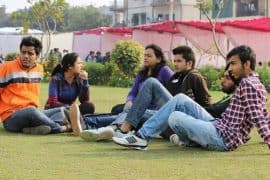“….. death of D.E.M.O’Cracy, mourned by his wife T. Ruth, his son L.I. Bertie, and his daughters- Faith, Hope and Justice”- read an anonymous advertisement in The Times of India soon after the declaration of Emergency.
Back in 1975, the Opposition, led by Jayaprakash Narayan organized a nationwide satyagraha against the then Prime Minister- Mrs Indira Gandhi, the response: Article 352 stamped over the political fabric of India, a stamp that sealed voices but not dissent. The fumes of Emergency engulfed the 25th day of June in 1975.
The Emergency brought about a buffet of special powers, from custodial deaths to press censorship; all cuisines were available, with draconian measures as the suggested garnishing. The buffet lasted for two years i.e. till 1977. But an irony- the common people failed to savour democracy for a long time.
When George Orwell said, “If liberty means anything at all, it means the right to tell people what they do not want to hear,” no one could fathom that Orwell was the Nostradamus of Indian Politics, and a basic democratic hue. Liberty would have dust patted over it. The Constitution’s claims of imparting Freedom of Speech and Expression, transitioned into a lie as the leaders and workers of the Opposition parties were arrested early in the morning. Furthermore, protests, strikes, and public agitations were disallowed. Strangulation of the Constitution had begun.
Media houses underwent a serious backlash as journalism came under the radar. Prior approval for all material to be published by newspaper was now a prerequisite. This was regarded as the violation of Article 19, while some defended the stance on Article 19(2). The demarcation and categorisation of events and facts remain a personal choice; however, the cutting off of electricity to all newspaper presses at 2:00 a.m. on 26th June 1975 is a fact to behold. The Prevention of Publication of Objectionable Matter Act of 1976 was another wave that hit the media. While the living document was being moulded according to events, dissent remained pristine – magazines like the Seminar and Mainstream chose not to submit to censorship and hence, closed down. Eminent newspapers like the Indian Express and the Statesman left blank spaces where news items had been censored.
On April 1976, the Constitution was virtually vandalized. The Supreme Court accepted the Government’s plea, which gave way to the Government to take away the Right to Life and Liberty. Preventive detentions were turned into arbitrary tools, custodial deaths and torture surfaced and resurfaced. Sanjay Gandhi’s involvement in demolitions and forced sterilisation were not merely controversial but unconstitutional. The common man suffered for days and the importance of civil liberties imparted through the Constitution became evident.
The Shah Commission of 1977 translated as a litmus test to the excesses. The magnitude of damage to the Constitution was deciphered. The Commission estimated that nearly one lakh, eleven thousand, people were arrested under preventive detention laws. It mentioned that the General Manager of Delhi Power Supply Corporation received verbal orders from the office of the Lt. Governor of Delhi to cut electricity to all newspaper agencies, restoration of electricity paved way two to three days after the censorship apparatus was set up. Displacement, relocation and sterilization scarred many lives.
After a long wait, 1977 reopened the gates of democracy. It was not only a moment to rejoice but a moment to reflect upon the past. Not only did citizens realize the value of the Constitution but also unravelled its ambiguities. Emergency was imposed on the grounds of ‘internal disturbance’ which was an enigmatic statement in itself. Emergency could now be proclaimed on the pretext of ‘armed rebellion’. It brought upon the realisation that the Constitution is a living document, and yet, has flaws dawned upon the citizens of the Nation. The 42nd Amendment was a shockwave as it was intended to be intransient in nature. The chaos and anarchy of 1975 amalgamated into the ‘first revision test’ of the Constitution that the Nation took. And similar to every surprise test, shock and realisation came hand-in-hand.
Image Credits: Countercorrents
Priyanshi Banerjee





Comments are closed.